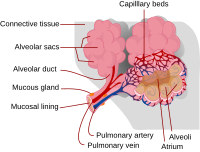
Photo from wikipedia
Introduction Type 2 cytokines such as IL-5, IL-13 and IL-4 produced by primed type 2 T cells have been shown to be important in the pathogenesis of eosinophilic airway inflammation. Factors… Click to show full abstract
Introduction Type 2 cytokines such as IL-5, IL-13 and IL-4 produced by primed type 2 T cells have been shown to be important in the pathogenesis of eosinophilic airway inflammation. Factors regulating the state of activation of these cells are incompletely understood. We and others have shown that release of IL-13 by stimulated T cells can be inhibited by epithelial cells. This study used a PBMC based bulk culture system to: 1) determine whether production of other type-2 cytokines is inhibited by co-culture with epithelial cells; 2) compare inhibition of activated PBMC and human lung lymphocytes and 3) investigate whether specific soluble mediators modified inhibition of IL-13 release. PBMC isolated from blood and lymphocytes isolated from lung tissue were cultured with IL-2 for five days in the absence and presence of A549 and BEAS2B epithelial cells. The cytokines IL-13, IL-5, IL-9 and TNFa were measured in the supernatant of these cells. Similar co-culture experiments were performed in the presence of different inhibitors or blocking cytokine antibodies. Results Production of all cytokines measured were reduced in the presence of epithelial cells: IL-13 shown as mean pg/106 cells+/-SD in 200 U/ml IL-2) PBMC: 1184+/-24,+A549 12+/-1 or lung cells 795+/-158,+A549 50+/-2. PBMC and lung cells were inhibited to a similar degree although, importantly, lung cells produced more IL-9 and less TNFa than a comparable number of PBMC. We found that adding inhibitors to IL-10, TGF-β, Aryl Hydrocarbon Receptor (AHR blocked with CH-223191), prostaglandins (indomethacin) and nitric oxide (NMMA) did not alter the A549 mediated regulation of IL-13 release by the PBMC or lung cells. Conclusions The inhibition of cytokine release by PBMC and lung cells in the presence of epithelial cells could indicate generalised regulation of inflammatory cytokine release. Blocking of IL-10, TGF-β, AHR, prostaglandins and nitric oxide was not able to reduce the regulation of the cytokine release but more specific inhibitors or further titration may be required. The characterisation of cells from lung tissue and the regulation of these by epithelial cells could further elucidate possible ways of regulating and reducing cellular inflammatory responses in asthma.
Journal Title: Thorax
Year Published: 2017
Link to full text (if available)
Share on Social Media: Sign Up to like & get
recommendations!